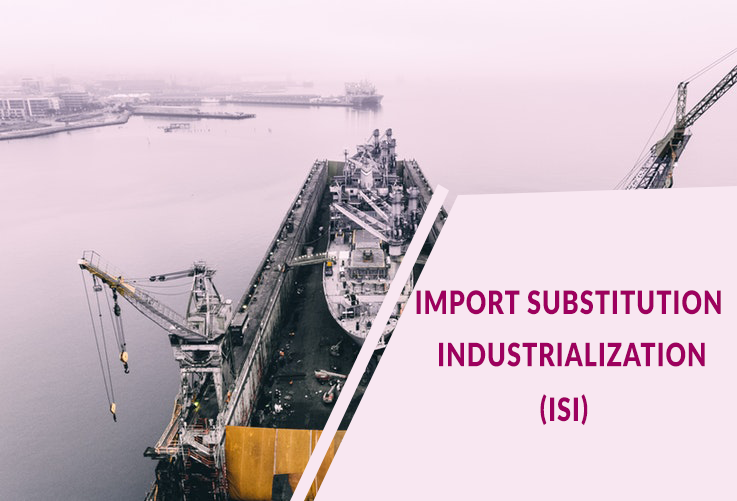Import substitution industrialization (ISI) is the exchange and financial strategy that advocates supplanting imported products with local generation rule that nations should decrease their remote reliance through the nearby generation of industrialized items on making independent economies.
Today, many nations still utilize such usage. ISI depends on the fact that a country should endeavor to diminish its outside reliance on the neighborhood generation of industrialized items.
The term primarily alludes to twentieth-century advancement financial matters strategies, even though it has been upheld since the eighteenth century by business analysts, for example, Friedrich List and Alexander Hamilton.
History of Import Substitution Industrialization
The ISI hypothesis rose in Latin American nations following World War II. The essential objective of the executed suggestion is to ensure, reinforce, and develop future projects using various strategies, including duties, import standards, and sponsored government credits.
Nations implementing this hypothesis intend to establish creation channels for each phase of an item.
This interpretation of import substitution industrialization runs counter to the monetary supposition of the relative preferred standpoint. So, nations have practical experience delivering products that give them a favorable position.
At that point, these countries look to send out these products globally.
Nations in the Global South authorized ISI approaches intending to deliver advancement and independence through forming an internal market.
Import Substitution Industrialization Stages
Import substitution industrialization works by having the state lead financial improvement through nationalization, appropriation of crucial businesses, expanded tax collection, and profoundly protectionist exchange approaches.
It was progressively deserted by creating nations in the 1990s because the World Bank and the IMF requested that their auxiliary change projects of worldwide market-driven advancement go for the Global South.
The arrangement was required to fuse three key stages. The main stage is a residential generation of already imported straightforward nondurable buyer merchandise.
The second is expanding suburban creation to a more extensive scope of shopper durables. Ultimately, the third step was the fare of produced products and proceeded with the recent expansion.
Issues with Import Substitution Industrialization
The arrangement of Import substitution industrialization activity has been looked at with different reactions over the previous decades. Some neoliberal backers scrutinized the strategy activity, and it was all the more detectable in the 1970s and 1980s. Worldwide bodies, particularly the Institutions of Bretton Woods assertion, and the approach creators, particularly the Western hegemony, were parts of the goading.
Instituted in 1989 by John Williamson, the term Washington agreement has become the bedrock of approach solutions for neoliberal/neoclassical ideologists. Henceforth, there is objection and aversion from the radicals who see the arrangement as a frivolity of colonialism as opposed to analysis for financial burdens.
Despite what the neoclassic proverbially accepted as an efficient showstopper, the neoliberal philosophy fought the economic pathway. It drove them up to these points, immature nations to the present award.
19s Social Strife
By the 1960s, ISI methodologies had noteworthy disadvantages. Even though outcomes fluctuated from nation to nation. General patterns included a generation that frequently only reached out to businesses. Other than buyer merchandise, moderate work development, rural division decay, and insignificant efficiency development.
Social strife additionally developed and was found to a limited extent to be coming about. It was because of expanded spiritual movement and a more noteworthy imbalance.
Although strong nations, for example, Brazil and Mexico, developed in any event here and now with the arrangements of import substitution industrialization. Little nations, including Ecuador and Honduras, could have been more fruitful.
Promoters of organized commerce instead censured ISI’s defensive measures. It contends that they made mutilations in capital allocation. They kept preventing nations from seeking similar favorable positions in global exchange.
Scholarly Viewpoints about Business Trends
New, secured businesses and government arrangements were wasteful, with those supported through market-drove advancement procedures. These studies are bolstered to some degree by early perceptions of fare-driven development in East Asia. It created a strong accentuation by commercial and improvement organizations on sending out advancement starting in the 1960s.
These scrutinized bring up important issues about improvement techniques and the state’s role in the 21st century.
Even though strategies of import substitution industrialization are seen not to have fulfilled their formative objectives, research reveals that drove and fare-driven development have additionally been reprimanded regarding universal exchange and with some acknowledgment of a part of the state being developed. The route for national governments to seek improvement remains a fundamental, open inquiry.
Social and Political History
A third viewpoint features the significance of national social and political histories to the achievement, or scarcity in that department, of ISI techniques. The capacity of the administration to learn and adjust generation procedures to nearby conditions depends on the character of neighborhood foundations and social associations.
Additionally, even though the makers of buyer merchandise may have been active at first, They needed more motivation to help the current extension since this would require the security of those enterprises on which they depended for their generation devices. It was constraining their supply of excellent sources of info.
Likewise, the open doors accessible to extend local creation into new enterprises were restricted by the absence of help by TNCs for household mechanical improvement, intensified by low levels of specialized preparation in the residential populace.
In every nation, the chance to extend the modern generation regularly depends on various social and political limitations.
Second Period of Import-Substituting Industrialization (ISI2)
The second period of Import Substitution Industrialization is ISI2. It included the move in Latin America to “overwhelming” industrialization from around 1950-80. This time of financial history has been upbraided by both the Left and the Right as being either increased reliance. Or one exhibiting the reasonable disappointment of state intercession in the economy.
An examination of an essential factual investigation utilized to go down other enlightening cases. The ISI2 period was one of blended achievement. With macroeconomic unpredictability, it was going with the incredible advance in GDP and assembling development.
As it were, the ISI2 time prevailed regarding industrializing the significant economies of the period. It stands out positively from the record of the succeeding worldview of neoliberalism. This examination note raises issues about how we look at the official time of ISI2 and proposes a more liberal viewpoint. It could prompt a more compelling and maintainable political economy worldview for the district later.
Low Government Control
As per Sebastian Edwards, an advocate of the neoliberal arrangements of the Washington Consensus, there are three reasons why ISI is viewed as a horrifying disappointment. Right off the bat, the over-the-top protectionism and summed-up government control enormously energized lease looking for exercises. It was making an unbending financial structure unfit to respond quickly to changing world monetary conditions.
Furthermore, numerous nations have a blend of open division spending plans and wasteful duty frameworks, expanding trouble. This lessened the government’s capacity to give social administrations productively and created an expanding level of disparity. By the late 1970s, the district had, by a wide margin, an unequal dispersion of wages on the planet.
Thirdly, due to frail open-back structures, many nations depend on inflationary financing to connect government consumption and incomes.
Fourthly, due to the internal system, we were incredibly disheartened, scarcely developing between 1960 and 1980.
Negative Impacts on Economies
The ISI2 period is viewed as an absolute disappointment by both dependents and neoliberals and is observationally false. While there were apparent issues, for example, rural profitability and macroeconomic unpredictability. A target appraisal couldn’t conclude that state-drove industrialization is a reasonable deadlock and neoliberalism is the appropriate response.
Then again, the sudden increment in US loan fees in the mid-1980s caused LA nations to forsake the constant development. And mechanical advance of the ISI2 and hold onto neoliberalism as a constrained type of delayed “stun treatment.
ISI additionally had a few negative results on economies. For example, the merchandise produced in Latin America, specifically Brazil, frequently needed to meet universal quality norms, forbidding them from contending in the global market. Additionally, quick industrialization exacerbated the gap between the rich and the poor by enabling the exclusive class and neglecting the creation of an entrepreneurial class.
Along these lines, LA governments should have observed the light of neoliberal contentions about the sacredness of the market. They were constrained to such conclusions by the conditions of commercial capital from one perspective and the confidence of Chilean advance on the other.
Chilean Model and Macroeconomic Instability
In any case, the Chilean model also implied expanding disparity and an absence of shared breakthroughs. Furthermore, the Chilean model has yet to be replicated in other LA nations looking for macroeconomic soundness.
Neoliberal business analysts proceed to disregard any acknowledgment of political elements. It will keep criticizing LA governments for not finishing on the essential “second era” changes required for a neoliberal framework to change itself.
Following Cárdenas, Ocampo, and Thorp’s (2000) apparent finishes, the ISI time frame is macroeconomic instability and salary imbalance, yet extraordinary modern advance.
Could such progress have prompted a more maintainable model or frame the reason for a restored rendition?
Jorge Katz contends that the macroeconomic flimsiness, vulnerability, absence of funds, venture, entrepreneurial soul, and unwillingness to advance fares imply that long-haul execution will undoubtedly be shoddy contrasted with Southeast Asian partners. Also, Katz (2000) contends that work efficiency and fare execution have enhanced in the present neoliberal time frame.
matreial Handling Ventures
The outcomes are gathered for the most part in “vast residential combinations and nearby auxiliaries of (MNCs) in crude material-handling ventures.
Despite this, many firms delivering articles of clothing, calfskin products, furniture, and machines shut down amid the 1990s. Little and medium endeavors have endured the most as of late.
This demonstrates new types of government petitions can enhance the dispersion of the advantages from late changes.
ISI strategies executed in Brazil in the post-World War II period could have been more manageable in any capacity. In any case, the most widely recognized stigmatism identified with ISI is that such industrialization was. At last, an improvement disappointment of the creating nations. Thus, attempting to imitate the commercial structures of the North did not compare honestly.
As per Werner Baer, extreme market twists by high and unpredictable assurance arrangements amid the industrialization of Latin American nations (Baer, 1972). This thought of aimlessness was accepted to prompt the advancement of profoundly wasteful and high-cost businesses.
In a more excellent adaptation, the record of ISI has been seen as “average development, wild protectionism, high, low profitability development, and progressive emergency.
Bottom Line
Import substitution industrialization macroeconomic strategy challenges the pointless prediction. It was exacted against it by establishing the Washington Accord and different foes. Primarily, reactions to the approach animate financial dejection, hinder development, and exacerbate rivalry in the local mechanical division. The total of what has been built up in this examination needs to be revised and, to some degree, unseemly.
Along these lines, when creating economies, particularly less industrialized economies, it is recommended to consider import substitution in the short run and fare advancement over the long haul as the nation produces an adequate assembly limit for empowering send-out.







